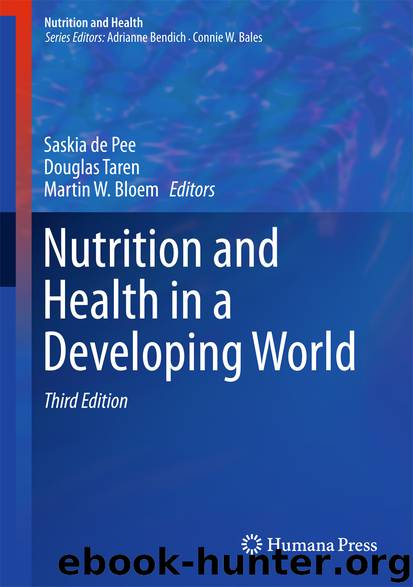Nutrition and Health in a Developing World by Saskia de Pee Douglas Taren & Martin W. Bloem

Author:Saskia de Pee, Douglas Taren & Martin W. Bloem
Language: eng
Format: epub
Publisher: Springer International Publishing, Cham
HIV coinfection is the single most potent risk factor for progression from infection to active disease, whether infection is from a new primary infection (e.g., recent exposure to bacteria) and/or reactivation of a latent infection (see Epidemiology section above). Since multiple exposures are possible, mixed (or multiple)-strain infections have been described, although the challenges to fully understanding the epidemiology (laboratory detection of mixed strains is difficult leading to gaps in knowledge), clinical (e.g., ability to comprehensively assess individual drug susceptibility/resistance with multiple strain infections), and population (e.g., transmission dynamics of competing strains, vaccine, and preventative therapy effects on circulating strains)-level implications are numerous [135]. Unlike many opportunistic infections that occur only with significant immunosuppression, TB can manifest with any degree of immunosuppression. If TB disease manifests in HIV-positive individuals who are not significantly immunosuppressed, then the disease course is similar to TB in HIV-negative individuals and is dominated by PTB in adults. If TB manifests once advanced HIV-associated immunosuppression has occurred, systemic disease involving multiple organs that lack well-defined granulomas with diffuse lesions is increasingly likely. Notably, all forms of EPTB have been described in HIV-associated TB, and this further complicates the clinical diagnosis of active TB in a resource-restricted setting. The specific nature of the immunological changes caused by HIV infection that drastically increase the likelihood of TB disease is complex and not fully understood [4, 136]. In general, untreated HIV infection leads to an absolute and functional decline in the cell-mediated immune response that is essential for maintaining lifelong immunological control of Mycobacterium spp. The destruction of T cells, specifically CD4+ cells in the granuloma by HIV, causes a change in the granuloma structure leading to the escape of viable bacilli.
Download
This site does not store any files on its server. We only index and link to content provided by other sites. Please contact the content providers to delete copyright contents if any and email us, we'll remove relevant links or contents immediately.
Nutrition for Sport, Exercise, and Health by Spano Marie & Kruskall Laura & Thomas D. Travis(3559)
Nutrition for Sport, Exercise, and Health by Marie Spano & Laura Kruskall & D. Travis Thomas(3554)
The Sprouting Book by Ann Wigmore(3419)
Flavor Flours by Alice Medrich(2650)
Memory Rescue by Daniel G. Amen(2262)
Superfood Smoothie Bowls: Delicious, Satisfying, Protein-Packed Blends that Boost Energy and Burn Fat by Chace Daniella(2240)
Dirty Genes by Ben Lynch(2164)
The Bad Food Bible by Aaron Carroll(2126)
The Poisoner's Handbook by Deborah Blum(1984)
Genius Foods by Max Lugavere(1978)
Good Calories, Bad Calories by Gary Taubes(1957)
The Main Street Vegan Academy Cookbook by Victoria Moran(1943)
The I Quit Sugar Cookbook by Sarah Wilson(1881)
Core Performance Essentials by Mark Verstegen(1864)
Memory Rescue: Supercharge Your Brain, Reverse Memory Loss, and Remember What Matters Most by Amen Dr. Daniel G(1851)
Big Girls Do It Stronger by Jasinda Wilder(1806)
Android App Development by Franceschi Hervé J.;(1736)
Sugar Crush by Dr. Richard Jacoby(1690)
Dr. Colbert's Keto Zone Diet by Don Colbert(1550)
